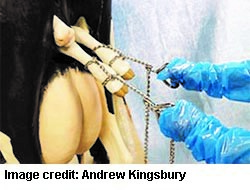By Dr. Megan Fritz, UMD College of Computer, Mathematical and Natural Sciences
Spring has arrived, and along with the seasonal increase in temperature comes increased tick activity. One important tick to keep watch for is the invasive Asian longhorned tick. Since 2017, populations of this tick have been identified in 9 states, including Maryland. This is particularly relevant for cattle producers because the tick is a significant pest of ruminant livestock in its Australasian and Western Pacific range.
Longhorned tick infestations can grow rapidly owing to their reproductive strategy and biting habits. The tick must feed on the blood of a warm-blooded host animal to grow and reproduce. Once blood fed, females of this species can reproduce without males, such that a single female can give rise to an entire population. Longhorned ticks bite aggressively, and are willing to feed on a wide variety of hosts: humans, birds, small mammals (racoons and skunks), companion animals (dogs and cats), large mammals (horses and deer), and other domesticated livestock, including cattle, sheep, and goats.
Heavy longhorned tick infestations can lead to severe blood loss, which reduces livestock growth and productivity. For example, dairy cattle production is reduced by 25 percent in some regions of New Zealand and Australia, where this tick is present. They also transmit pathogens between their hosts during blood feeding. These include multiple parasites and pathogens that cause disease in ruminant livestock, as well as at least one virus known to cause severe illness in humans. To date, no pathogen transmission by the longhorned tick has been detected in the U.S.
To prevent the ill-effects of any tick infestation, early detection is key. Cattle should be examined for ticks throughout the course of the season. Calves are most susceptible to tick feeding, so reducing their contact with dense pasture reduces risk of high tick burden. Proper pasture management, such as clipping pastures and fence lines, and controlling broadleaf weeds can reduce suitable habitat for ticks. Removing brush and woody debris from pasture edges may also reduce habitat for wild animals, like mice, rabbits, squirrels and raccoons, that can carry ticks into your pasture. If you find an infestation in your pasture, whole animal insecticide treatments, like Permectrin™ II and Ultra Boss™, may be useful for preventing new tick attachment to your animals. Sprays and pour-on treatments cannot be used alone for comprehensive livestock protection, however. An integrative approach to tick management, which combines pasture management with good husbandry and chemical prophylaxis is crucial for livestock protection.
If you find ticks on your animal and you are concerned:
- Collect a few of the ticks by tweezing them from the skin of your animal. They are most easily removed by grasping the tick close to the skin of the animal using a pair of blunt-ended tweezers, then gently pulling on them at a 45 degree angle from the animal’s skin. Once removed, immediately stick them to a piece of masking tape, and place them into a ziploc bag with a moist paper towel. Tick collections can be taken to your local University of Maryland Extension office or shipped directly to:
Dr. Megan Fritz
4291 Field House Dr.
Plant Sciences Building Rm. 4112
College Park, MD 20742
- Call your University of Maryland Beef Cattle Extension Coordinator, Racheal Slattery, at 301-405-1392, or your University of Maryland Medical and Veterinary Entomologist, Megan Fritz, at 301-405-3945.
- Call your local veterinarian and alert them to your tick infestation. Many veterinarians in the state of Maryland are working with the Maryland Department of Agriculture to address stakeholder concerns regarding the long-horned tick.
